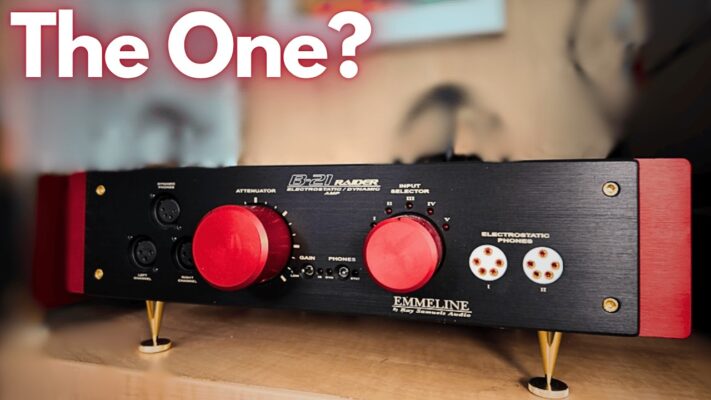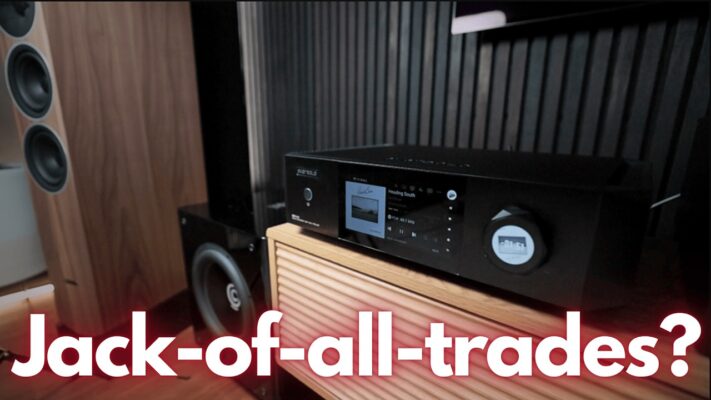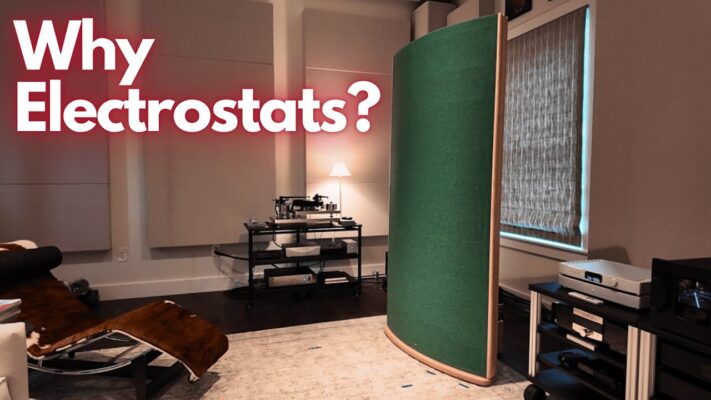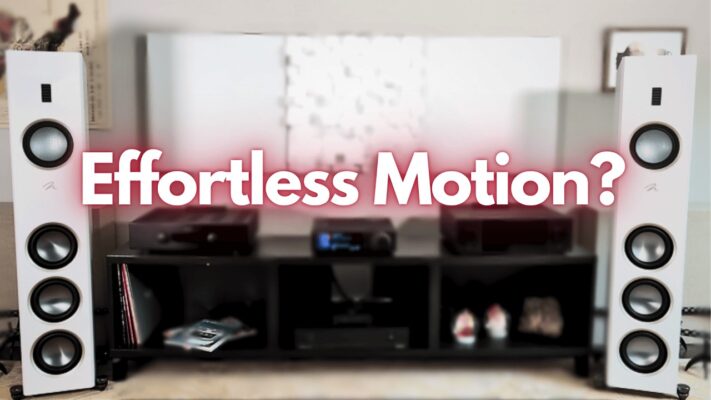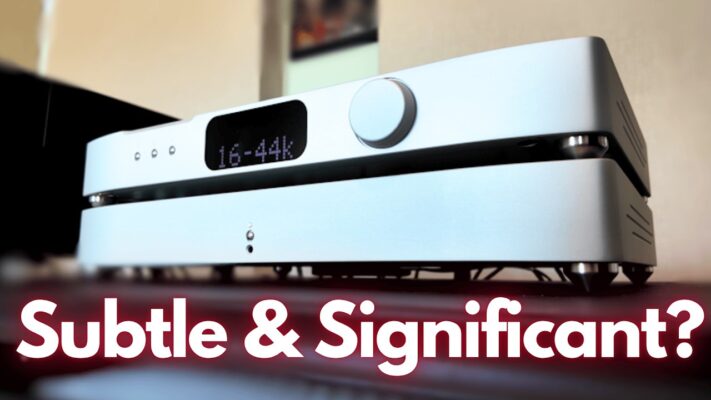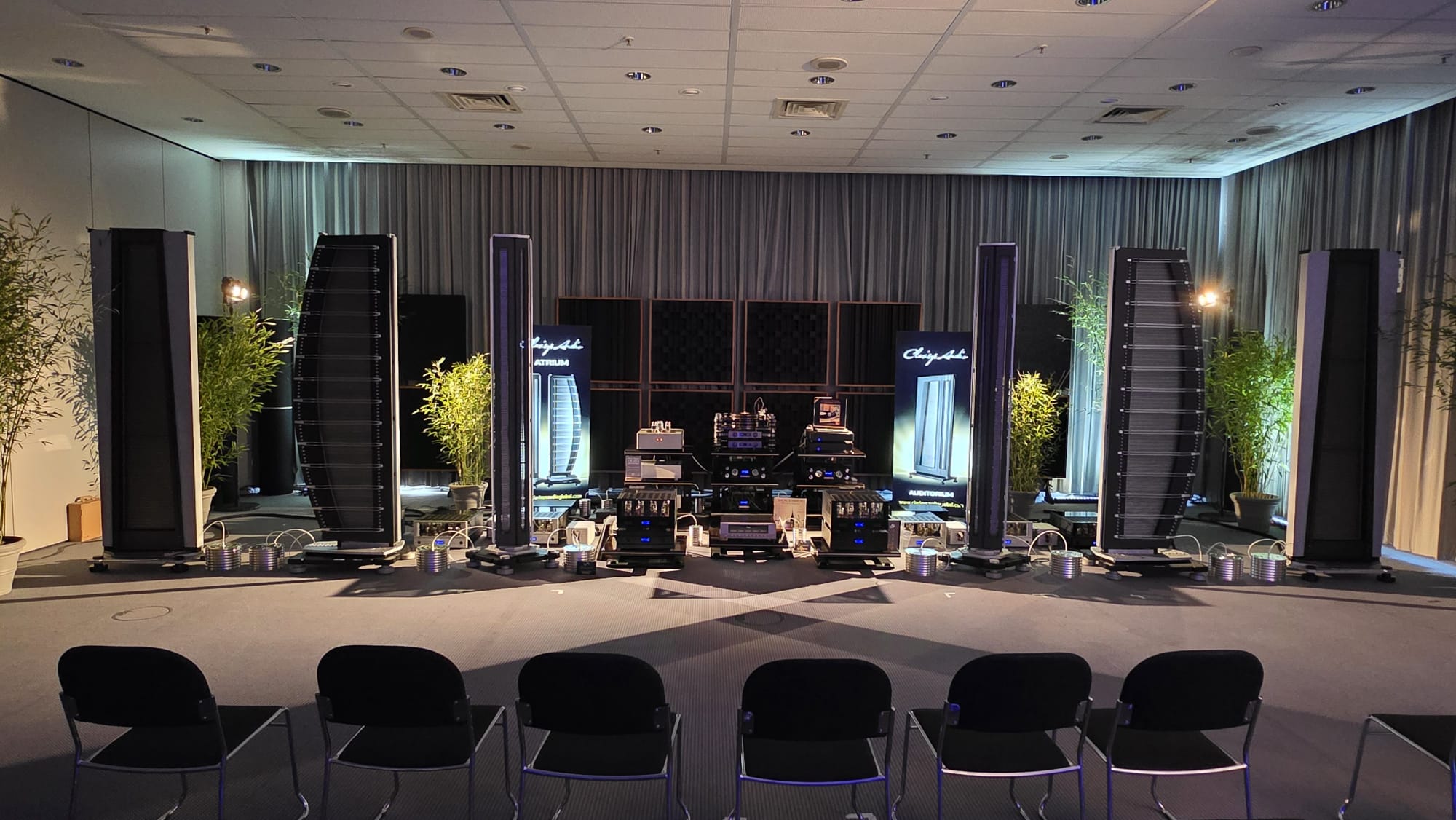
The question of what counts as a new product at an audio show is fraught. At least it is for me. “New” ought to refer to a finished design that’s just coming to market, being shown to the audio community for the first time. But it’s understandable that a manufacturer who has gone to the trouble and expense to bring a truckload of equipment to a show will hope for a mention (or, better yet, an enthusiastic recommendation) after appearing in Munich in mid-May with the same gear it brought to Chicago a month earlier. What are the rules? Do different capacitors in a crossover, an additional finish option, a limited “anniversary edition” or a product’s first trip across the Atlantic warrant the designation of “new?” What am I thinking, anyway, when I ask a manufacturer, “Do you have anything new at the show?” I’ve yet to have one respond: “Oh, no— just the same old, same old. See you at Capital!”
In lieu of employing a lie detector, truth serum, or interrogation methods forbidden by international law, I’ve decided to lighten up and expand the definition of “new,” at least a little bit. So: If we mentioned the product in our AXPONA report, we’ll skip it this time around. But if the product was shown at a regional show six months ago, but Munich or Chicago or Rockville was our team’s first exposure to it, it’ll count as new. Or at least “newish.”
Five Most Significant Product Introductions
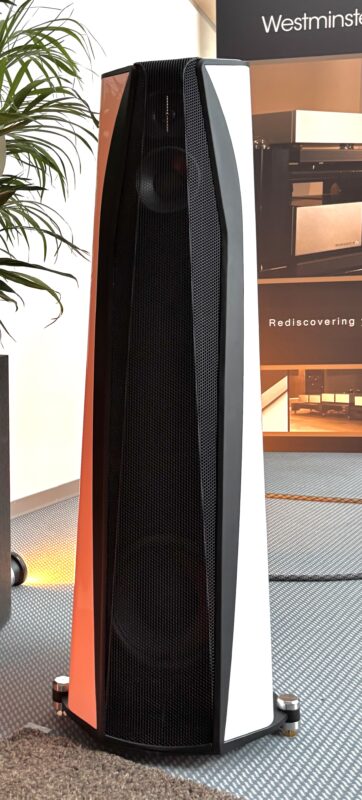
Aequo Audio, based in Holland, has been in business for about a decade but is unfamiliar to many North American audiophiles, me included. This could be about to change. The company is poised to introduce two new loudspeakers, the Adamantis passive 3-way ($37,900) and the Ensium 500-watt bass-assisted 3-way ($44,900) that represent the first commercial implementation of a Nanotech material called Diluvite MMC. This “metal matrix composite” has unique physical properties that Aequo has leveraged to both sonic and aesthetic advantage. Diluvite is an extremely inert material that converts vibration into heat: Rapping your knuckles on the enclosure results in an dull thud (and sore knuckles.) In addition to minimizing cabinet resonances, Diluvite can be readily formed into “complex organic shapes” that aren’t just easy on the eyes but also serve to further control vibration. At High End 2025, with the Ensium driven by Westminster Lab electronics, an unidentified recording of Saint-Säens’ Danse macabre manifested rich orchestral textures, great imaging, and plenty of musical detail.
The 3-way, four-driver Magico S2 ($34,000/pair for Softek finish; $39,100 for gloss finish) has replaced the 2-way S1 at the “bottom” of the brand’s S Series. In physical size and sound, the new model has much more in common with the current S3 than the now-retired S1 but is less visually imposing. (It’s also between $11,450 and $13,400 cheaper than the S3.) Sonically, the S2 is every bit a Magico—fast, well-balanced across the frequency spectrum, with a characteristically lean but never cool aural presentation. Over the course of a 15-minute audition in Munich, it was obvious that the new speaker does well spatially, with vocals imaging way out into the room.
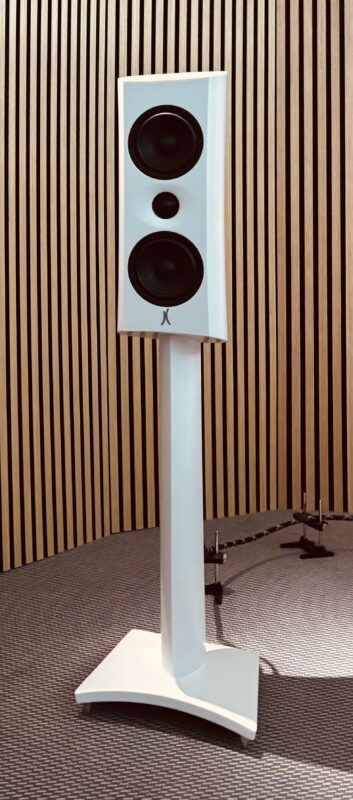
Estelon has added to its A series of more affordable products—the floorstanding Aura (€17,500/pair) became available in 2023—with the Aurelia (€14,900/pair, €17,900/pair with stands), the Aurelia Centre (€7500) and the Aurus subwoofer (€13,500). Other than Aura, these “real world” Estelons don’t have the sensual curves that characterize the bigger models, and their enclosures are made of a thermoformed mineral composite rather than crushed marble material used to cast the Extremes, Forzas, and other much costlier models. But you are definitely not slumming if you decide to own a pair of the standmount Aurelias, not aesthetically and not sonically. As played at the Munich show with MSB electronics, they manifested the detail retrieval, tonal consistency, and ease of presentation associated with their larger brethren. And note, tech bros: Instead of traditional stands (€3000/pair) to put on the floor, for the same price you can get an elegant version to support the Auras on a desk or countertop. That should be one helluva nearfield listening experience, though I doubt you’ll get much work done.
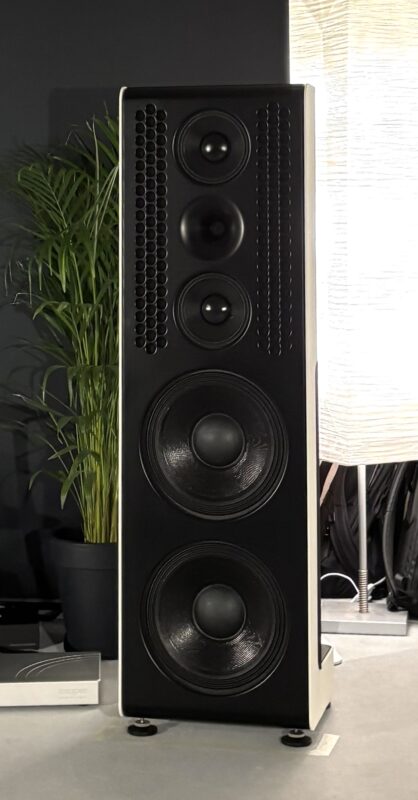
The Lithuanian loudspeaker manufacturer Silent Pound—don’t ask about the name; I haven’t a clue—brought two speaker models to Munich, the floorstanding Challenger II (€28,000) and the Bloom stand-mount (€14,900.) Both are designed with the same fundamental principle in mind: “Silence the Room” is the Silent Pound motto. Two key design features serve to minimize room interference. First, a unique dipole bass transducer reduces the amount of acoustic energy radiating into the listening space by close to 5dB. Second, a patent-pending midrange enclosure promotes a highly dimensional presentation and, to my ears, an exceptional evenness of top-to-bottom frequency response. In a very small room, I requested some very dynamic and bass-heavy material (large-scale symphonic music, big band, etc.)—and, if blindfolded, would have thought I was listening to a bigger speaker in a much larger space, far away from any room boundaries. I texted RH to come and hear the Bloom, and he was similarly impressed. Silent Pound has dealers in 14 countries, though not as yet in North America. Cofounder and CTO Audrius Balciunas told me the company is working to address that deficiency.
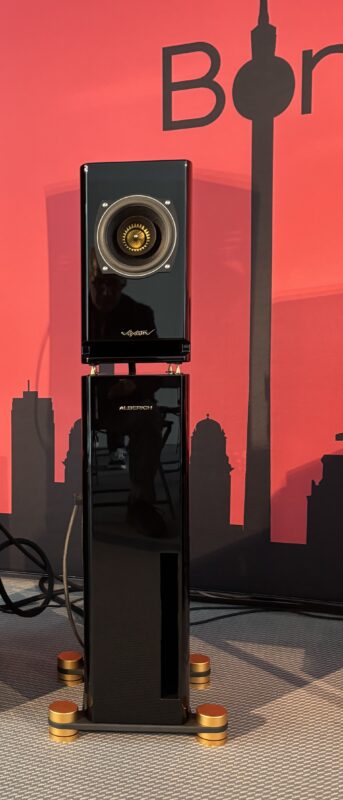
Voxativ’s Alberich bass module was designed to accompany their Hagen back-loaded horn mini-monitor. Together, they comprise the Alberich2 System, a modular full-range loudspeaker with a frequency response of 20–33,000Hz and a price starting at €17,900. (In case you’re not a German opera buff, Alberich and Hagan are the father/son villains in Richard Wagner’s Ring cycle.) The Alberich2 is an active design, with a 500-watt Class D amplifier on board, and there is, as well, the capacity for a user to adjust several key parameters—level, crossover frequency, and phase—to optimize performance in a specific listening environment.
Auspicious Debuts
When audiophiles think of the ELAC brand, they may think of the Andrew Jones era and the many lower priced models that are currently sold by Music Direct, Crutchfield, and B&H. These are, for sure, products with a high performance-to-price ratio. Many are unaware that ELAC is a German company with a history dating back close to a century, and their catalog includes plenty of pricy, no-compromise gear. The latest example is the Concentro M807 (€22,000/pair) that was proudly introduced at High End 2025. It’s an elegantly contoured 4-way bass-reflex design, weighing in at 137 pounds per side. The high-midrange element is comprised of six small drivers, arranged concentrically around ELAC’s venerable JET 6c AMT tweeter. 4.5” low-midrange drivers are positioned above and below that grouping, and there are two downward-firing 10” woofers. A selector on the rear panel allows the user to choose one of five modes that alter the mix of direct and diffuse sound to best suit the room’s acoustic character.
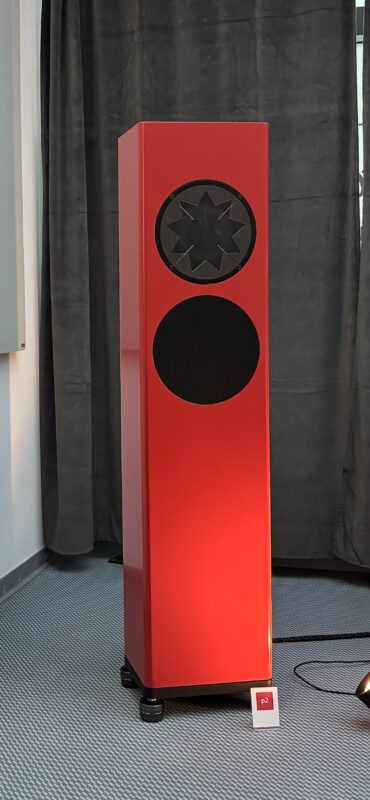
Manger Audio’s p2 (€15,600 per pair) isn’t a new speaker but sports a redesigned version of the Manger driver, the “bending wave” transducer invented by the brand’s founder, Joseph W. Manger (1929–2016.) His daughter, Daniela, an engineer who has run the company for decades, explained that the latest interation utilized in all Manger models has a stronger motor system, revised damping parameters, and a redesigned chassis—all resulting in improved linearity, less distortion, and superior dynamics. The Manger driver operates from 340 to 4500Hz and is mated in the p2 with a traditional 8” woofer in a sealed enclosure. Manger had plenty of quality vinyl on hand with which to demo the speaker; the familiar Reference Recordings Symphonic Dances (Oue/Minnesota) sounded terrific.
The Piega Premium 801 ($10,000 per pair) is the first product from the Swiss manufacturer to feature a horn-loaded ribbon tweeter, a good-sized one that operates down to 2500Hz, positioned above five identical-appearing cones, one of which is a midrange transducer, two are woofers, and two are passive radiators. Bass was certainly authoritative. This is an active loudspeaker design with functions that can be controlled with the supplied remote.
A new Dutch company, Sphinx Audio-Engineering is on the verge of releasing two loudspeaker models, the Element 3and the Element 5. Both invoke ancient Egypt with an exquisite, sculpted appearance, the enclosures fabricated from a “stone-like material” not unlike the Corian® utilized for kitchen countertops. The price of the smaller Element 3 is expected to be $38,000–$40,000 per pair. Sphinx isn’t actually a new brand, having been first established in the 1980s but now “reimagined” thanks to the resources of Siltech and Crystal Cable. The enclosure is ported to the front, featuring a proprietary system to optimize bass performance known as “Zero Gravity” that targets compression artifacts to reduce distortion. Bass output is adjustable with rear-panel switches; LF output is rated down to 23Hz.
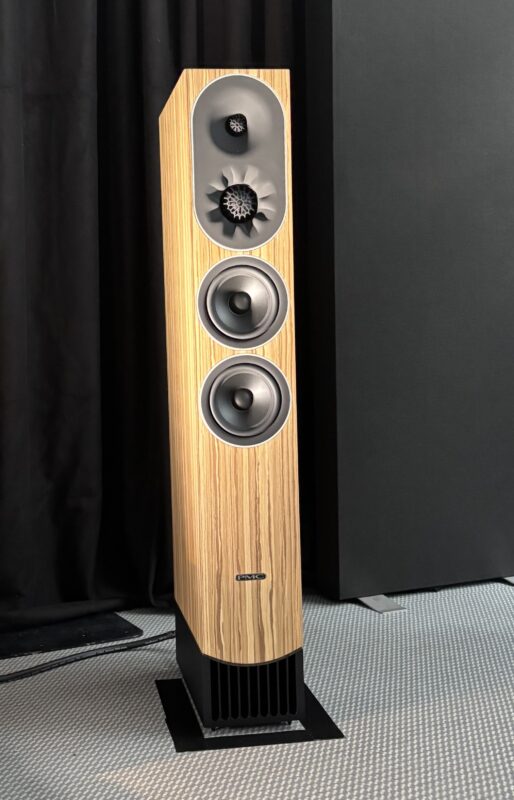
My friend and colleague Alan Taffel had positive things to say about the PMC Prophecy7 he heard at AXPONA this year, and I was equally impressed with the British manufacturer’s Prophecy9 ($12,999/pair.) Extended bass is produced by a pair of custom-built high excursion 5” woofers implemented in a transmission-line design, combined with a patented airflow technology (“LaminairX”) that greatly reduces the audibility of port chuffing. Soft dome tweeter and midrange drivers are housed in a profiled baffle with a unique waveguide. Prophecy speakers are used at the Teldex studios in Berlin, and the company representative proudly played two Haydn selection recorded there—one for chorus and orchestra, the other a keyboard concerto—to great effect.
In the Auer Acoustics room, I was handed a small block of tankwood, a compressed natural wood product that’s used to construct the cabinets of the company’s Versura line of loudspeakers, including the top-of-the-line V4 (€45,000/pair.) The stuff is dense and heavy, and although the speaker doesn’t visually overpower a room—the front baffle is less than 9” wide— each V4 weighs well over 200 pounds. Bass is prodigious but articulate, down to 20Hz, we’re told. Yet the speaker can be light on its feet: Nothing got in the way of appreciating the pyrotechnics of a solo violin playing a Paganini etude.
The Wilson Benesch Horizon ($39,000) had actually debuted in the UK earlier this year, but Munich was its first appearance at an audio show outside of England. The Horizon is the least costly model in Wilson Benesch’s reference line of floorstanders, sharing technologies utilized in the company’s most ambitious products. The room was very noisy but, from what I could hear of L’histoire du soldat, powered by Lumin amplification, the Horizons demonstrated the characteristic dynamic nuance and tonal accuracy of other speakers from this elite manufacturer.
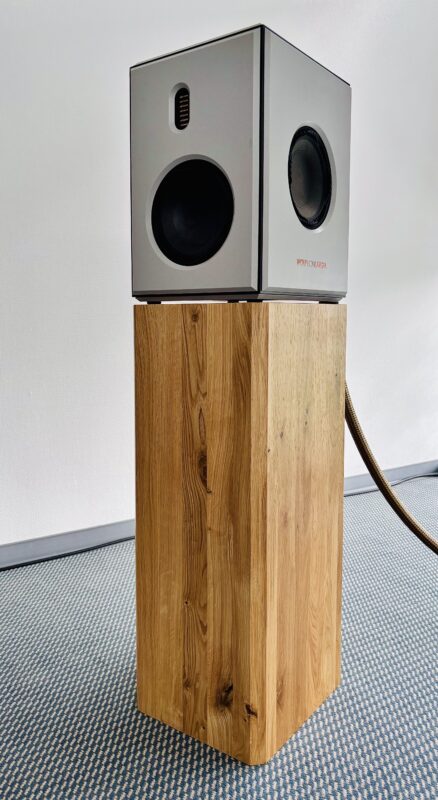
Wolf von Langa (the man) was playing his Wolf von Langa Sensitivity+ standmount speaker ($11,000/pair, plus $1000 for stands), a two-way design that eschews his favored field-coil technology to bring a top-notch product to market at a lower price. The driver complement includes an AMT tweeter, a cone midrange, and two passive radiator woofers. For a small speaker, dynamics were excellent.
Revival Audio, located in the Alsace region of France, had its newest product on hand, the Atalante 7 Évo (€9390/pair.) The speaker definitely has a retro look to it—boxy, with a furiniture-like dark wood finish. It’s another 3-way, this one sporting a 15” woofer with an unusual basalt sandwich construction. The –6dB low-frequency output was 23Hz, and bass performance was subjectively very good: A walking acoustic bass line was even and well-deliniated. A robust stand that gets the 32-inch-tall speaker up another foot in the air is included in the price.
Among the least expensive speakers I came across at High End 2025 were the Triangle Borea BR04 bookshelf model, at $550/pair, with stands an additional $279/pair. It’s a 2-way model that actually can be located on a bookcase, countertop, or workdesk because the port faces forward. The tweeter is a 25mm device that’s crossed over to a 6” mid/bass driver; the frequency response is given as 44Hz to 22kHz. Unusual at this price point is that there are two sets of binding posts per speaker, and biwiring is an option. Vocals had considerable presence, and synth bass had gratifying impact and extension.
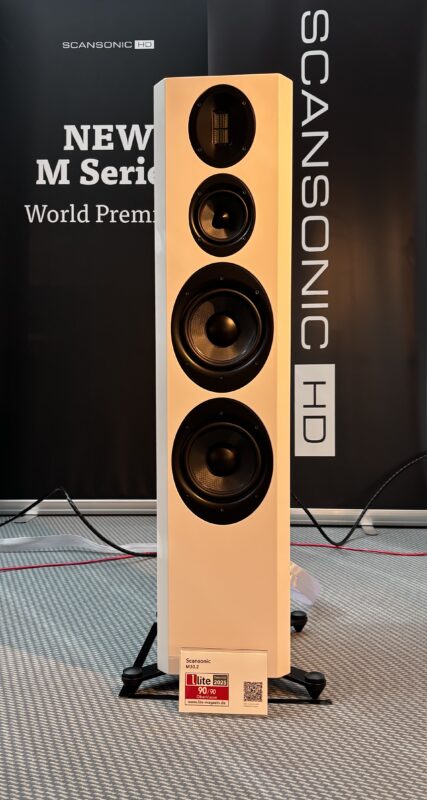
Scansonic is a sort of minor league affiliate of Raido Acoustics offering four lines of loudspeakers—L, M, MB, and Q. The MB and Q series products are built in Denmark by the same people who craft Raidhos. The M series products are made in China, a fact that Scansonic seems to obsfuscate in its slick brochure. It shouldn’t matter, as the M models are also built to a high standard…but audiophiles can have biases against Asian-made gear. The M30.2 sits at the top of the M series line, a robust 3-way floorstander priced at €3500/pair. The speaker stands 43” tall and weighs about 55 pounds. The drive units include a neodymnium ribbon tweeter, a 4” mid/woofer with a honeycomb cone, two 6.5” woofers, also with honycomb membranes, and two passive bass radiators with paper diaphragms. With Vivaldi, pop, big band, and large-scale orchestral fare—with anything you threw at them—the M30.2s sounded excellent when played loudly. I would strongly suggest you don’t worry about the China aspect if this is your budget for full-range loudspeakers.
One reason High End 2026 will be held in Vienna is that the Munich Olympic Center simply can’t accommodate everyone who wants to strut their stuff on the world’s biggest stage for perfectionist audio. In recent years, an increasing number of brands excluded from the MOC have set up shop across the street at MotorWorld München, a large automotive-oriented mall with shops, restuarants, hotels, meeting rooms, and, of course, hundreds of rare and valuable cars to purchase or just oggle. Certainly, the oddest Motorworld exhibit space is a decomissioned railway car outside the main building in which I found the small loudspeaker manufacturer Airplain. (That’s right: A company called Airplain in a railway car at MotorWorld—trains, planes, and automobiles.) Their Model 5 (€20,000/pair) had an AMT tweeter positioned in a relatively tall but slender baffle above four 4” Purifi cones; the speaker delivered a satisfying rendition of my go-to orchestral test track, Bernard Haitink’s 2010 performance of the Allegretto from Shostakovich’s Symphony No. 15. It was well worth the trek over from the MOC, though it will be nice to, presumably, have everything under one roof next year.
In Other News
I was told that the OePhi Reference 3, made in Denmark and heard in its near-finished form at High End 2025, will sell in North America for around $20,000 per pair. High frequencies are handled by a 1.5cm true ribbon tweeter that’s mounted in a sub-enclosure that protrudes from the main structure of the cabinet. Combined with a midrange driver and a pair of woofers sourced from Purifi, the system functions from 25 to 40,000Hz, providing an easy load for the hARtmonoblock amplifiers that were driving it via OePhi’s own cables. The simple oak finish was beautifully executed. Another prototype that seems promising is The Pylon Audio Amethyst Gamma, an all-out audiophile effort from an established Polish manufacturer. The speaker is striking in appearance—the enclosure is wood applied to a composite material. The drivers were designed in house and the sound was noteworthy for a complete lack of coloration and excellent front-to-back layering. The company representative steadfastly declined to give even a ballpark estimate of the expected price.
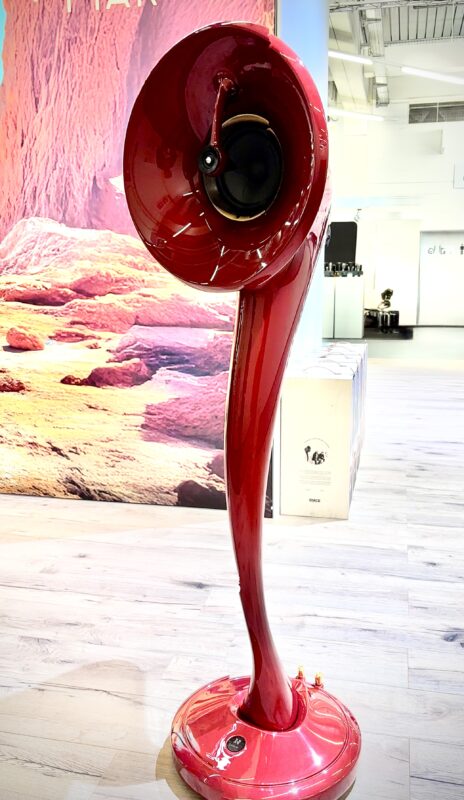
Among the most distinctive-looking products in any category were those from Once Custom Sound, a brand established in Turkey (I defy you to name another Turkish loudspeaker manufacturer.) These curvy, whimsically shaped transducers included the Nar, priced at €24,900/pair. Exotic as it appeared, the Nar is fairly conventional in its design, with drivers sourced from ScanSpeak— a 7” Illuminator paper cone woofer and a ¾” ring dome tweeter.
Among the strangest back stories I encountered at High End 2025 was that of the Indiana Line Utah 8 (€1650/pair). The brand came into being in the late 1970s in Salt Lake City and subsequently moved to Indiana. But it wasn’t economically feasible to make loudspeakers at a low price point in the U.S., and the company went under. It was subsequently resuscitated by an Italian firm, Alcor, who kept the name because it was felt that an American association would be good for sales. In 2006, the brand was taken over by another entity—Coral—and Indiana Line has established itself as one of the best known Italian loudspeaker brands (even if the typical owner has no idea where Indiana or Utah can be found on a map.) The Utah 8s may be pretty pedestrian looking but, sonically, they represent good value— a worthy consideration for a home-theater installation or in a fledgling audiophile’s first system.
Qobuz Connect
Well ahead of High End 2025, industry attendees were invited to a 90-minute press conference to be given by Qobuz, promising that a consequential announcement would be forthcoming. Although I secretly hoped that Qobuz might be telling the assembly about plans for streaming full-resolution immersive content—a Dolby TrueHD Atmos option—most in the audience of several hundred industry people were already aware that this would be the official roll-out of Qobuz Connect, a technology that’s been in the beta-testing phase for some time now, and aims to make the streaming experience more user-friendly.
Several representatives from the company recounted Qobuz’s history since its founding in 2007, contrasting its business model and operating practices to those of a certain malignant Goliath—Qobuz will never have a free, ad-supported subscription option, they pay the rights holders of the music they stream more generously, there’s an emphasis on non-compressed content—and reported on the growth of the service’s utilization in various markets. (The word “Spotify” wasn’t uttered for at least the first 20 minutes of the presentation.) Qobuz launched in the United States on Valentine’s Day, 2019, and American subscribers now account for 23% of Qobuz’s audience—more than in France, where the company is based. But there were some issues that could make using the service clunky, especially if a listener used multiple devices in the course of their music consumption.
Qobuz Control centralizes music control for subscribers, controlling playback with the Qobuz app, regardless of where the service is being used. It will be easy to switch between different devices—say, from a portable, headphone-based system to one’s serious indoor rig—without missing a beat, so to speak. The playback queue is synchronized across all of one’s devices, and optimal audio quality is assured. Access to all the editorial content, provided by the human curators that work for Qobuz, will be available, whatever device is being utilized. Around 60 hi-fi brands have already signed on and will be providing owners with the necessary firmware updates. The service is available to Quboz subscribers with the Studio or Sublime plans at no additional cost over what they’re currently paying.
Immersive Audio at High End 2025
The (Very) Good, the (Not too) Bad, and the Ugly
To this point, immersive audio demonstrations at audio shows have been a big disappointment, not making a good case at all to audiophiles with little or no experience with spatial music of any kind. There were four such demos at the Munich show, and I heard three of them; scheduling problems precluded my attending the one offered by Lyngdorf Audio, which I certainly regret.
Over at MotorWorld, Cabasse was playing a new product called The Pearl Theater. The system is “scalable,” in the sense that the user decides how many channels he or she wants. For $9990, one gets a 5.1.2 speaker complement—seven identical 7.5cm spherical satellites and a subwoofer, plus a versatile AV receiver and two peripheral 50-watt amplifiers that communicate wirelessly with the main unit to power the surround and height channels. The presentation began with Mad Max on screen, never a good sign, the high-ceilinged, rather reflective space progressively filling with automotive mayhem and explosions. On the video monitor, I noted a chamber music demo option, which I requested, to be rewarded with the most incoherent performance of (I think) Schubert’s “Trout” Quintet I’ve ever heard—too loud, with absolutely no sense of an ensemble playing together in a real space. I fled.

SVS did better in one of the small prefab listening rooms (“cabins”) in Halle 3. The 5.1.2 loudspeaker array (all SVS, of course) included two Ultra Evolution Titan floorstanders in front ($4000), an Ultra Evolution Center ($800), two Ultra Evolution Nanos ($900) for surrounds, two Ultra Evolution Elevations ($900) as height channels, and a pair of SB17-Ultra RIEvolution subwoofers ($2700 each.) The AV receiver was a Marantz Cinema 40 ($3500) and discs were played on a vintage Oppo. The demo began with a movie (A Star Is Born) but soon made its way to a Steve Wilson immersive mix that gave much more of a sense of the potential for spatial music to provide an audiophile experience.
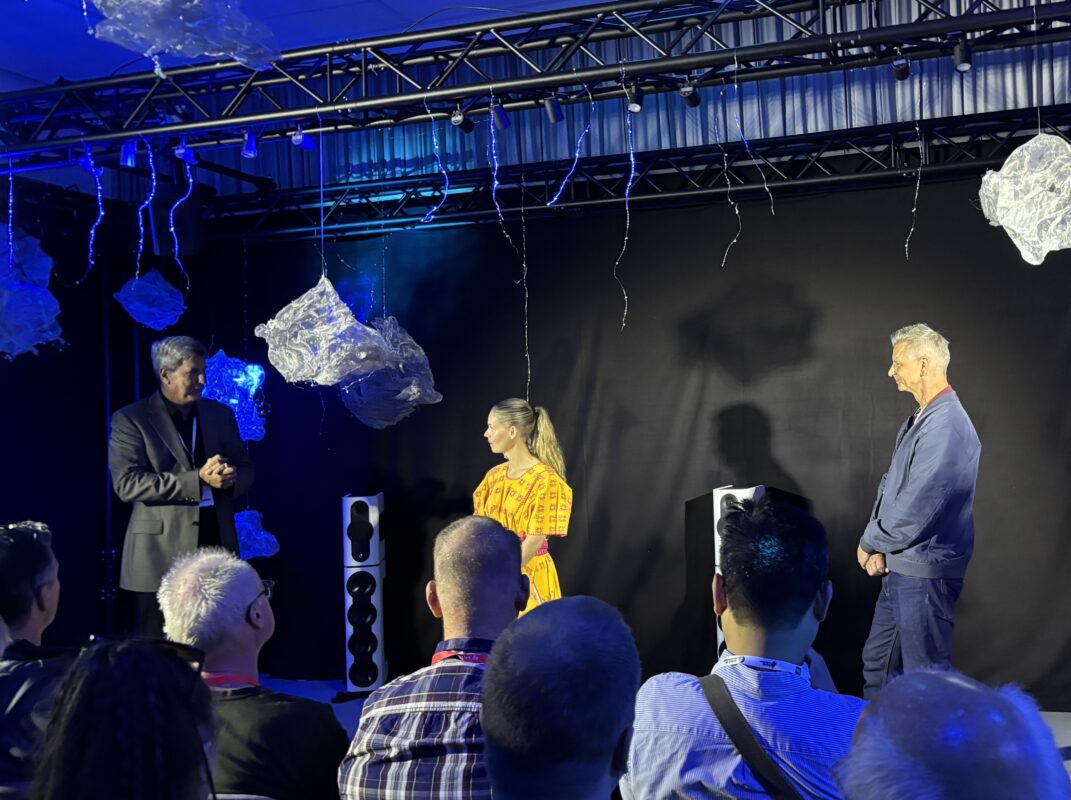
But there was a full-bore immersive audio experience at High End 2025 for a lucky few who had planned ahead and signed up for Kii Audio’s demo in a large Black Box Theater kind of space, accessorized with abstract, dimly glowing sculptural forms suspended from the high ceiling. The small number of reserved spots had been long claimed by the time the show began (there were seats for 20 at a time and the Munich show reportedly had close to 23,000 visitors this year), but I showed up anyway on Friday morning to beg and plead. The guy at the door pointed to an empty seat in the back row and I sat down just as the lights were going down.
The 7.1.4 speaker array included a trio of Kii Three speakers for the front left, center, and right channels with BXT active bass stands, plus a total of eight Kii Sevens for the surrounds, rears, and four height channels. (The total estimated cost of the loudspeakers was €80,000.) A Lyngdorf MP60 processor ($15,600) sent signal to the powered speakers via Ethernet.
With only the dim illumination afforded by those hanging sculptures, the music began. I had no idea of what to expect but recognized it immediately—an audio show staple of recent years, “Liberty” by the Norwegian singer/pianist/songwriter Anette Askvik. Askvik’s pure, plaintive, unadorned vocal, sparingly accompanied by electric piano, cello, sax, and minimal percussion, filled the space completely, enveloping the audience in a sensual embrace. It was ineffably beautiful. A second song by the same artist followed, then the house lights came up to a round of appreciative applause. And there she was in a bright yellow dress—Askvik herself, along with the engineer responsible for the immersive mix. She spoke convincingly about how she felt the engineering we’d just experienced had advanced the musical meaning of her music.
The Pure Audio Blu-ray disc, which holds both 7.1.4 Atmos and Auro-3D versions of the program, as well as 5.1 DTS-HD and high-resolution LPCM stereo programs was on sale at a booth near the theater and I practically flung my credit card in the direction of the salesman without asking the price. This is progress. This is good.
ANDREW QUINT’S BEST OF SHOW
Best Sound (Cost no object)
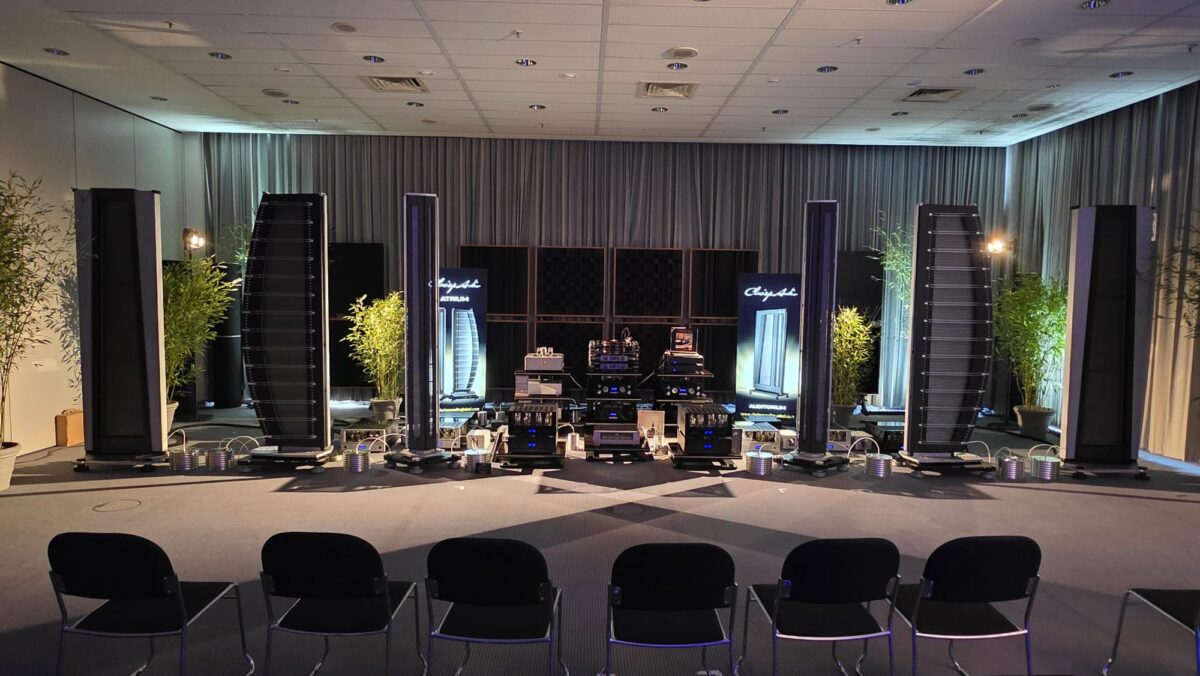
The Clarisys Room. No question. This system, featuring the six module Clarisys Audio Atrium loudspeakers ($785,000) plus VAC electronics, an Accuphase DF75 active crossover, Pink Faun and Lampizator digital components, a Kronos/MySonic Lab analog front end, and AudioQuest cables, was bound to impress simply for its complexity, cost, and ability to render large-scale music without any suggestion of stress or compression. But it may have been the natural rendering of space that was most impressive: I felt as if I could get up from my seat and walk forward among the orchestral players or big band musicians I was listening to. Remarkably, the effect was just as good with small groups. This was as convincing a simulacrum of live music—any kind of live music—as I’ve ever heard.
Best Sound (Cost considered)
In the Real (Audio) World where most of us live, the capacity to play music that’s loud and low is an eternal challenge. If the family or condo association doesn’t constrain you, the typical listening room will. The speakers from Silent Pound—both the Bloom stand mount (€14,900) and the Challenger II floorstander (€28,000) take the room out of the equation, without any room treatment, to a remarkable degree.
Most Significant Trend
Maybe it was just some sort of sampling error but, 60 years after Oskar Heil invented the technology, it seems like utilization of Air-Motion Transformer (AMT) high-frequency drivers, is becoming increasing common. Even just a decade ago, they were sort of exotic. I don’t think I heard the word “beryllium” spoken once the entire weekend.
Most Random Demonstration Music Trend
For as long as I can remember, female jazz vocals have been the favorite genre in stereo stores and audio shows, so much so that it’s become a cliché. For some reason, deep-voiced men were all the rage in Munich. If I hear “16 Tons” one more time, I can’t be responsible for my actions. Is the antidote and hour or two of Nora and Diana?
Tags: SHOW REPORT LOUDSPEAKER MUNICH
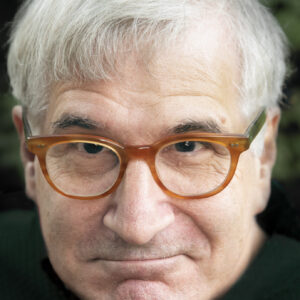
By Andrew Quint
More articles from this editorRead Next From Show
See all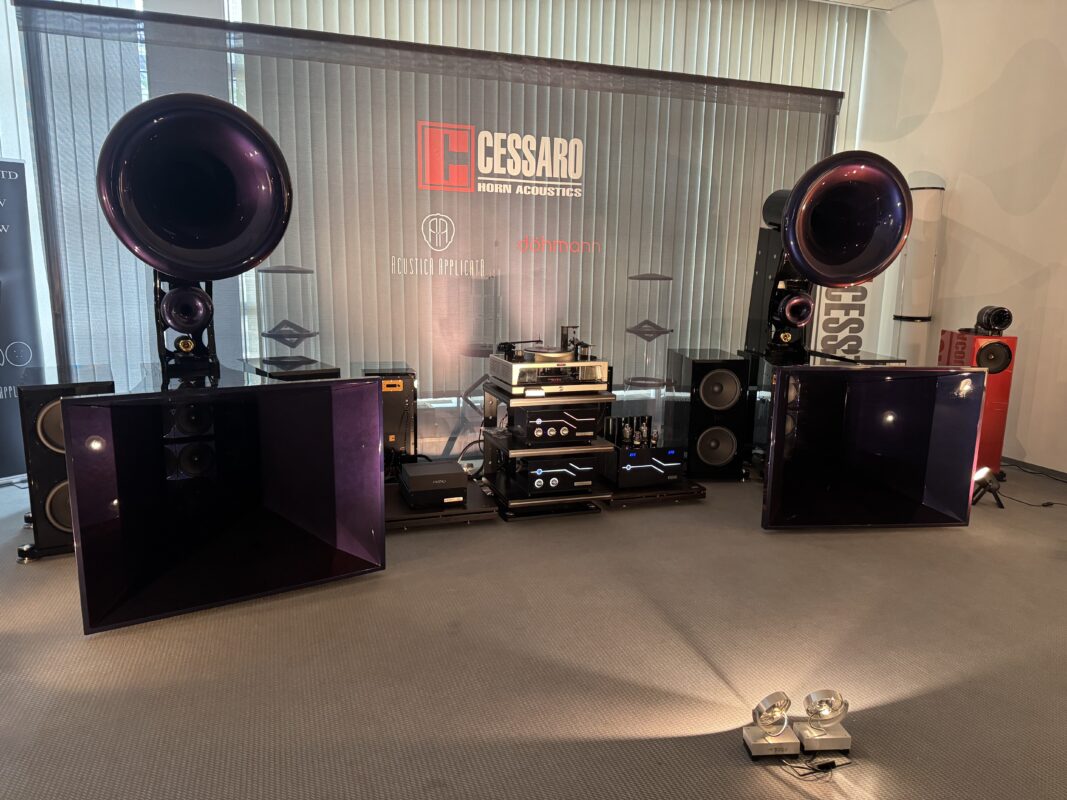
High End Munich 2025: Highlights
- May 30, 2025
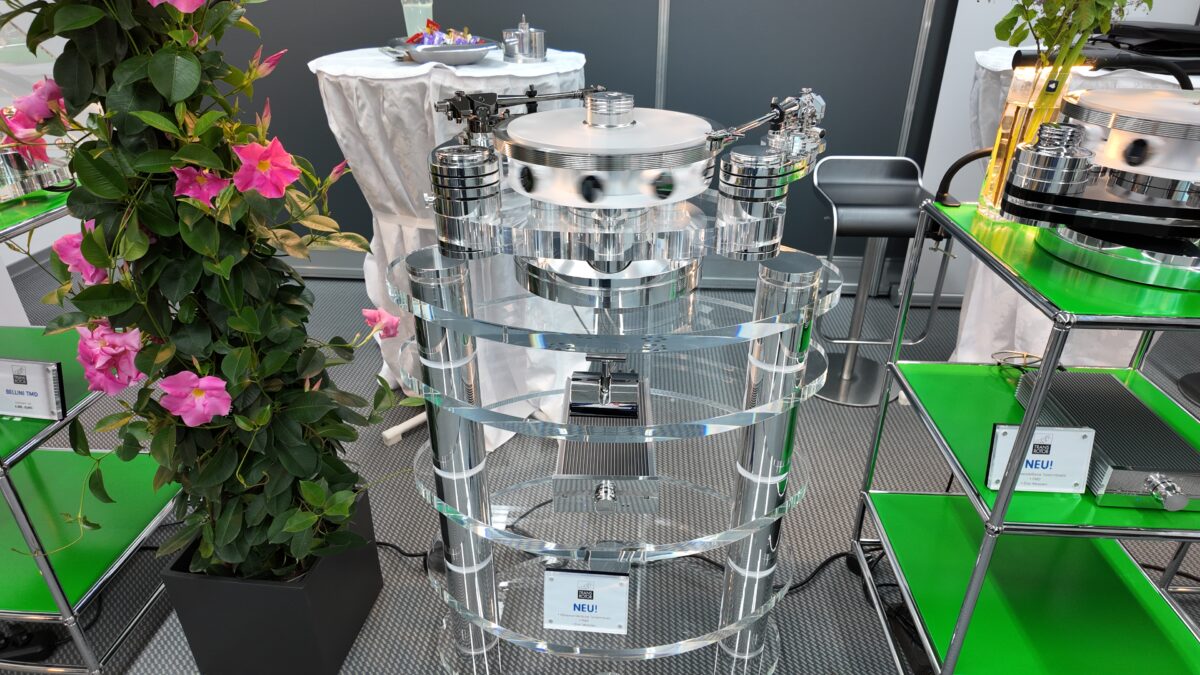
High End Munich 2025: Michael Fremer on Analog
- May 30, 2025
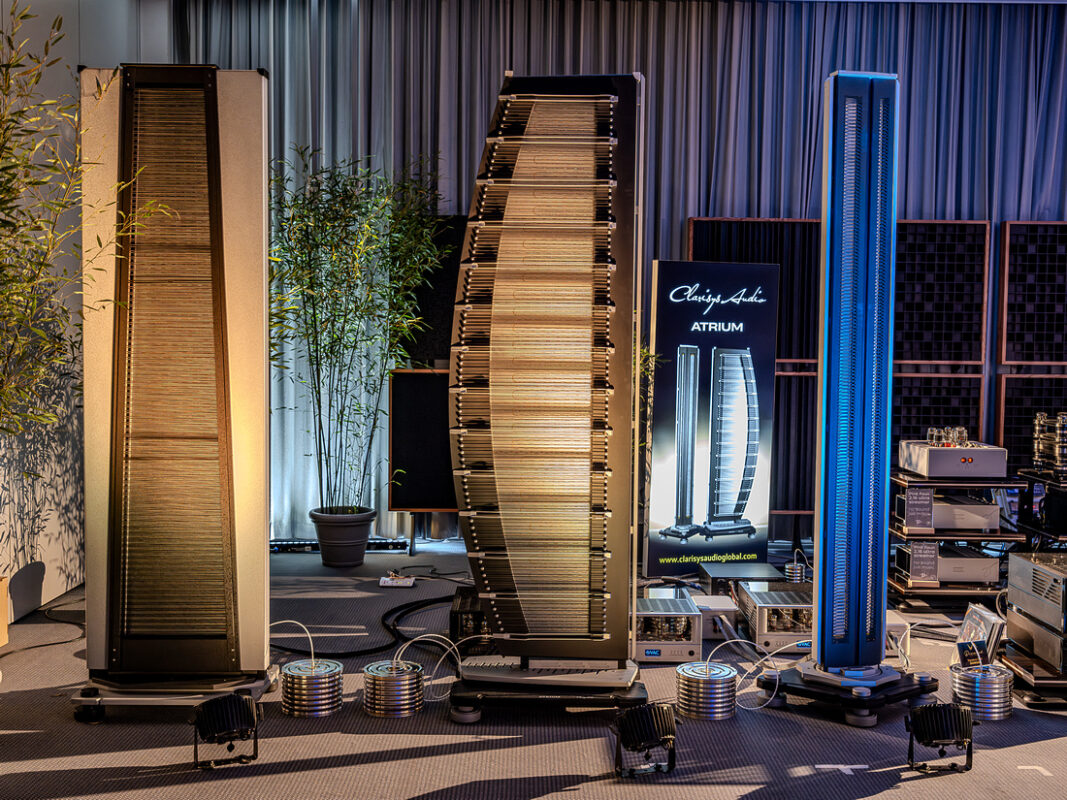
High End Munich 2025: Loudspeakers $50k and Up
- May 28, 2025










